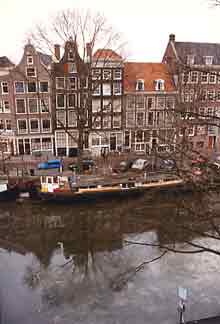|
 This is the view out of the window of the attic that Anne Frank lived in for years. In some ways not much has changed on these streets and canals, and in some ways it's all changed. This is the view out of the window of the attic that Anne Frank lived in for years. In some ways not much has changed on these streets and canals, and in some ways it's all changed.
|
|
Many people suffered during World War II. Many of them were European Jews, tormented by the hate of Adolf Hitler and his followers. One young girl, Anne Frank, became famous in the heart of people around the world because of her journals of life at that time. Her first hand account of the fear and hardships that she, her family, and many others went through is a powerful reminder of one of the darkest times in our history.
Anne Frank was three years old when her family moved from Germany to the Netherlands in 1933, fleeing the spreading grips of Nazi power. The Germans invaded the Netherlands in 1940. Anne recalled later in her diary on June 20, 1942 what it was like, "After May 1940 the good times were few and far between! First there was the war, then the capitulation and then the arrival of the Germans, which is when the trouble started for us Jews. Our freedom was severely restricted by a series of anti-Jewish decrees."
The diary, that would later become one of the most famous and important pieces of post-war literature, was Anne Frank's thirteenth birthday gift. On June 12, 1942 she wrote, "I hope I will be able to confide everything to you, as I have never been able to confide in anyone, and I hope you will be a source of comfort and support."
Soon after Anne's birthday, on July 5, 1942, Margot Frank, her older sister, was called by the S.S. to their "job creation programme." On July 6, 1942 the Frank family went into hiding in the "Secret Annex." Anticipating the worst, the Frank family had set up a small apartment in the back of Otto Frank's, her father's office. A bookshelf was placed over the door to the annex to hide it from view and opaque paper put over the windows.
The Frank family was later joined by Mr. and Mrs. van Daan and their son Peter and Mr. Dussel, to live with them for over two years. They were forced to stay inside at all times, "not being able to go outside upsets me more than I can say, and I'm terrified our hiding place will be discovered and that we'll be shot," Anne wrote on September 28, 1942.
|
|
|
|
On August 4, 1944 the Germans raided the Secret Annex after an anonymous tipoff. It is still unknown who betrayed the small group of people living there. Otto Frank's secretary, Miep Gies, who was also one of the helpers saved Anne's diary as well as some loose papers she found with it. A few days later the Germans returned and confiscated all the furniture.
Edith Frank-Hollandernder, Anne's mother, died on January 6, 1945 in Auschwitz. Margot and Anne Frank had been moved from Auschwitz to Bergen-Belsen before this. Here they contracted typhus, and in March of 1945 Margot died. Anne died only a few days later, believing that she was the last left in her family, not knowing that her father was still alive. That April the camp was liberated. Otto Frank was the only one from his family to survive and after the war he returned to Amsterdam. Miep Gies gave him Anne's diary and the papers she had saved when it was clear that Anne was not going to return for them herself.
The loose papers were a second draft of her diary that Anne had been working on in anticipation of it being published after the war. She wrote, "you've known for a long time that my greatest wish is to be a journalist, and later on a famous writer . . . In any case, after the war I'd like to publish a book called "The Secret Annex." It remains to be seen whether I succeed, but my diary can serve as a basis." Otto Frank worked to have the diary published and in 1947 the first edition was published in Dutch.
In 1953 Otto Frank married Fritzi Geiringer and they worked on the further distribution of the book. In 1950, Anne's diary was published in French and German. In 1952 the first English edition appeared and by 1955 the diary was published in 55 different languages including Bengal, Serbo-Croation and at least one Eskimo language.
When we visited the Anne Frank house it was in the middle of remodeling. Modern thingy-ma-jigs and whatsitz were lying all over the place, cluttering the imagination and cramping visions of what it would have been like to live there. The house is still lacking any kind of furniture, Otto Frank had requested it stay as the Nazis had left it, but I thought it left too much for the imagination to fill in and replace. It was still a very touching memorial to Anne and her family, and all those who suffered so much during and after the war.
|
|